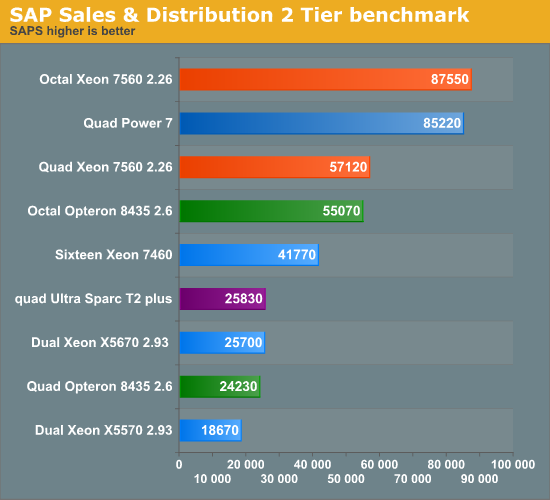High-End x86: The Nehalem EX Xeon 7500 and Dell R810
by Johan De Gelas on April 12, 2010 6:00 PM EST- Posted in
- IT Computing
- Intel
- Nehalem EX
SAP S&D 2-Tier
| SAP S&D 2-Tier | |
| Operating System | Windows 2008 Enterprise Edition |
| Software | SAP ERP 6.0 Enhancement package 4 |
| Benchmark software | Industry Standard benchmark version 2009 |
| Typical error margin | Very low |
The SAP SD (Sales and Distribution, 2-tier internet configuration) benchmark is an interesting benchmark as it is a real world client-server application. We decided to look at SAP's benchmark database. The results below all run on Windows 2003 Enterprise Edition and MS SQL Server 2005 database (both 64-bit). Every "2-tier Sales & Distribution" benchmark was performed with SAP's latest ERP 6 enhancement package 4. These results are not comparable with any benchmark performed before 2009. The new "2009" version of the benchmark obtains scores that are 25% lower. We analyzed the SAP Benchmark in-depth in one of our previous server oriented article. The profile of the benchmark has remained the same:
- Very parallel resulting in excellent scaling
- Low to medium IPC, mostly due to "branchy" code
- Somewhat limited by memory bandwidth
- Likes large caches (memory latency!)
- Very sensitive to sync ("cache coherency") latency

Since we gather the benchmark data from the SAP site, we have to work with what we found so far. A quad Xeon X7560 outperforms an octal-core Opteron 8435 at 2.6GHz by small margin (3%). A quad Opteron 6176 at 2.3GHz should score about 48k-50k. That is competitive performance, but this market will probably prefer the Xeon platform, as price is less an issue and reliability features are on top of the checklist. The Power 7 servers outperform the Nehalem EX CPUs, but the top models (3.55GHz) cost around $100k.










23 Comments
View All Comments
JohanAnandtech - Tuesday, April 13, 2010 - link
"Damn, Dell cut half the memory channels from the R810!"You read too fast again :-). Only in Quad CPU config. In dual CPU config, you get 4 memory controllers, which connect each two SMBs. So in a dual Config, you get the same bandwidth as you would in another server.
The R810 targets those that are not after the highest CPU processing power, but want the RAS features and 32 DIMM slots. AFAIK,
whatever1951 - Tuesday, April 13, 2010 - link
2 channels of DDR3-1066 per socket in a fully populated R810 and if you populate 2 sockets, you get the flex memory routing penalty...damn..............!!!!!!!!!!!!!!!!!!!!!!!!!!!!!! R810 sucks.Sindarin - Tuesday, April 13, 2010 - link
whatever1951 you lost me @ Hello.........................and I thought Sauron was tough!! lolJohanAnandtech - Tuesday, April 13, 2010 - link
"It is hard to imagine 4 channels of DDR3-1066 to be 1/3 slower than even the westmere-eps."On one side you have a parallel half duplex DDR-3 DIMM. On the other side of the SMB you have a serial full duplex SMI. The buffers might not perform this transition fast enough, and there has to be some overhead. I also am still searching for the clockspeed of the IMC. The SMIs are on a different (I/O) clockdomain than the L3-cache.
We will test with Intel's / QSSC quad CPU to see whether the flexmem bridge has any influence. But I don't think it will do much. You might add a bit of latency, but essentially the R810 is working like a dual CPU with four IMCs just like another (Dual CPU) Nehalem EX server system would.
whatever1951 - Tuesday, April 13, 2010 - link
Thanks for the useful info. R810 then doesn't meet my standard.Johan, is there anyway you can get your hands on a R910 4 Processor system from Dell and bench the memory bandwidth to see how much that flex mem chip costs in terms of bandwidth?
IntelUser2000 - Tuesday, April 13, 2010 - link
The Uncore of the X7560 runs at 2.4GHz.JohanAnandtech - Wednesday, April 14, 2010 - link
Do you have a source for that? Must have missed it.Etern205 - Thursday, April 15, 2010 - link
I think AT needs to fix this "RE:RE:RE...:" problem?amalinov - Wednesday, April 14, 2010 - link
Great article! I like the way in witch you describe the memory subsystem - I have readed the Intel datasheets and many news articles about Xeon 7500, but your description is the best so far.You say "So each CPU has two memory interfaces that connect to two SMBs that can each drive two channels with two DIMMS. Thus, each CPU supports eight registered DDR3 DIMMs ...", but if I do the math it seems: 2 SMIs x 2 SMBs x 2 channels x 2 DIMMs = 16 DDR3 DIMMs, not 8 as written in the second sentence. Later in the article I think you mention 16 at different places, so it seems it is realy 16 and not 8.
What about Itanium 9300 review (including general background on the plans of OEMs/Intel for IA-64 platform)? Comparision of scalability(HT/QPI)/memory/RAS features of Xeon 7500, Itanium 9300 and Opteron 6000 would be welcome. Also I would like to see a performance comparision with appropriate applications for the RISC mainframe market (HPC?) with 4- and 8-socket AMD, Intel Xeon, Intel Itanium, POWER7, newest SPARC.
jeha - Thursday, April 15, 2010 - link
You really should review the IBM 3850 X5 I think?They have some interesting solutions when it comes to handling memory expansions etc.